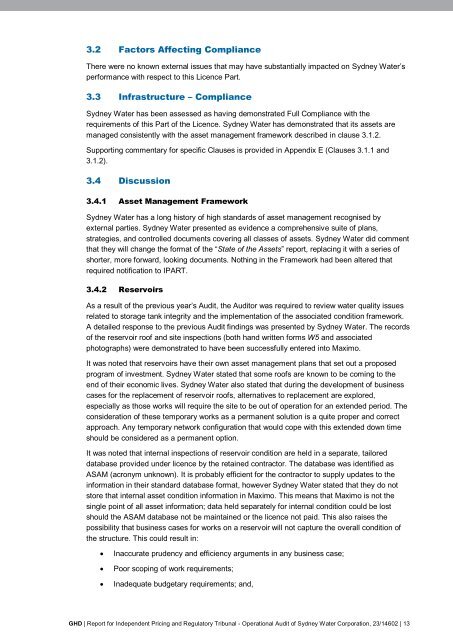Sydney Water Operational Audit 2011/2 - IPART - NSW Government
Sydney Water Operational Audit 2011/2 - IPART - NSW Government
Sydney Water Operational Audit 2011/2 - IPART - NSW Government
You also want an ePaper? Increase the reach of your titles
YUMPU automatically turns print PDFs into web optimized ePapers that Google loves.
3.2 Factors Affecting Compliance<br />
There were no known external issues that may have substantially impacted on <strong>Sydney</strong> <strong>Water</strong>’s<br />
performance with respect to this Licence Part.<br />
3.3 Infrastructure – Compliance<br />
<strong>Sydney</strong> <strong>Water</strong> has been assessed as having demonstrated Full Compliance with the<br />
requirements of this Part of the Licence. <strong>Sydney</strong> <strong>Water</strong> has demonstrated that its assets are<br />
managed consistently with the asset management framework described in clause 3.1.2.<br />
Supporting commentary for specific Clauses is provided in Appendix E (Clauses 3.1.1 and<br />
3.1.2).<br />
3.4 Discussion<br />
3.4.1 Asset Management Framework<br />
<strong>Sydney</strong> <strong>Water</strong> has a long history of high standards of asset management recognised by<br />
external parties. <strong>Sydney</strong> <strong>Water</strong> presented as evidence a comprehensive suite of plans,<br />
strategies, and controlled documents covering all classes of assets. <strong>Sydney</strong> <strong>Water</strong> did comment<br />
that they will change the format of the “State of the Assets” report, replacing it with a series of<br />
shorter, more forward, looking documents. Nothing in the Framework had been altered that<br />
required notification to <strong>IPART</strong>.<br />
3.4.2 Reservoirs<br />
As a result of the previous year’s <strong>Audit</strong>, the <strong>Audit</strong>or was required to review water quality issues<br />
related to storage tank integrity and the implementation of the associated condition framework.<br />
A detailed response to the previous <strong>Audit</strong> findings was presented by <strong>Sydney</strong> <strong>Water</strong>. The records<br />
of the reservoir roof and site inspections (both hand written forms W5 and associated<br />
photographs) were demonstrated to have been successfully entered into Maximo.<br />
It was noted that reservoirs have their own asset management plans that set out a proposed<br />
program of investment. <strong>Sydney</strong> <strong>Water</strong> stated that some roofs are known to be coming to the<br />
end of their economic lives. <strong>Sydney</strong> <strong>Water</strong> also stated that during the development of business<br />
cases for the replacement of reservoir roofs, alternatives to replacement are explored,<br />
especially as those works will require the site to be out of operation for an extended period. The<br />
consideration of these temporary works as a permanent solution is a quite proper and correct<br />
approach. Any temporary network configuration that would cope with this extended down time<br />
should be considered as a permanent option.<br />
It was noted that internal inspections of reservoir condition are held in a separate, tailored<br />
database provided under licence by the retained contractor. The database was identified as<br />
ASAM (acronym unknown). It is probably efficient for the contractor to supply updates to the<br />
information in their standard database format, however <strong>Sydney</strong> <strong>Water</strong> stated that they do not<br />
store that internal asset condition information in Maximo. This means that Maximo is not the<br />
single point of all asset information; data held separately for internal condition could be lost<br />
should the ASAM database not be maintained or the licence not paid. This also raises the<br />
possibility that business cases for works on a reservoir will not capture the overall condition of<br />
the structure. This could result in:<br />
<br />
<br />
<br />
Inaccurate prudency and efficiency arguments in any business case;<br />
Poor scoping of work requirements;<br />
Inadequate budgetary requirements; and,<br />
GHD | Report for Independent Pricing and Regulatory Tribunal - <strong>Operational</strong> <strong>Audit</strong> of <strong>Sydney</strong> <strong>Water</strong> Corporation, 23/14602 | 13
















